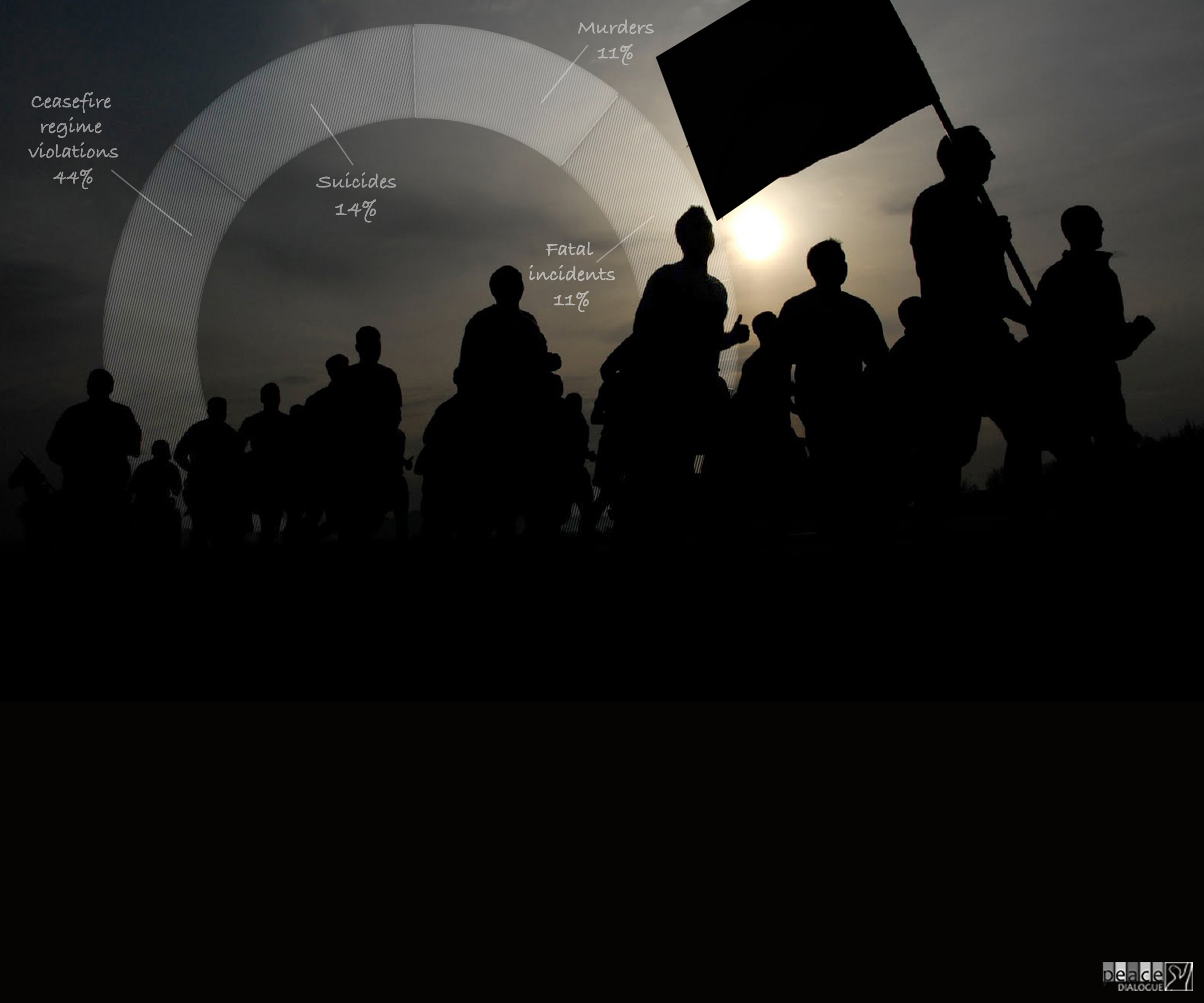
April-June 2017
Peace Dialogue is presenting the current issue of its quarterly report on the conditions of Human Rights in the RA Military Forces. Peace Dialogue is an Armenian non-governmental organization active in peace building, democracy and human rights. One of the main spheres of its activities is monitoring human rights violations in the RA Armed Forces, in pursuit of justice and initiation of public debate on current issues in the Armenian Armed Forces, particularly aimed, but not limited to, at seeking relevant solutions and promoting those solutions by presenting them to the Armenian authorities and relevant international actors.
This report includes current analysis of the organization, court cases and their status and covers the following topics:
- Representatives of religious organizations and the situation of the freedom of thought, conscience and religion in the armed forces.
- The ambiguity of the terms “suitable for military service” and “suitable with restrictions” in the RA law.
- The death cases recorded in the Armenian Armed Forces during the first half of 2017.
- Information related to the investigation of private soldiers Grigor Avetisyan’s and Souren Aramyan’s death cases.
- Update on the court case of the death of Private Manuchar Manucharyan.
- Update on the court case of the death of Private Haroutyun Hambaryan.
- The Administrative Court rejected the requirement to force the Ministry of Defense to provide information to Peace Dialogue.
1. Representatives of religious organizations and the situation of the freedom of thought, conscience and religion in the armed forces
“Spiritual presence has never been part of our army, though the Armenian clergy has always been next to the Armenian warrior especially during wartimes holding the victorious sacred cross of Jesus with one hand and the spear with the other.” – is mentioned in the article “The Spiritual Service in the Armenian Armed Forces” posted on the website of the RA Ministry of Defense.
According to the article the Spiritual service of the Armenian Apostolic Church in the ARM Armed Forces has been performed since 1997. Spiritual service of the Armenian Apostolic Church in the ARM Armed Forces is established by the encyclical of the Catholicos of All Armenians. With the decree of the ARM Defense Minister it is a part of the ministry structure. Main objectives of the spiritual service are to introduce Bible, New Testament and main principles of Christianity to the staff of the ARM Armed Forces as well as educate them with Christian moral principles and national patriotic spirit.
In order to understand the role of the religious groups in the army, the peculiarities of their activities as well as all the mechanisms that ensure the provision of the right of conscious and religion, Peace Dialogue NGO sent the following enquiry to the Ministry of Defense:
“According to the article The Spiritual Service in the Arm Armed Forces, the clergymen give lectures, make relevant conversations with soldiers, encourage them during border post rotations with their prayers, visit border outposts, and organize featuring of educational movies, pilgrimages, liturgies and other religious ceremonies.
Considering that Article 1, Paragraph 3, Point 3 of the RA Law on Military Service specifies that the serviceman has no right to be a member of any political party, religious or trade union, and the sixth paragraph of the same section prohibits the use of official positions for the benefit of political parties, religious and public associations and campaign for the benefit of their activities, we kindly ask you to clarify:
- Based on which legal acts the spiritual activity of the Armenian Apostolic Church in the Armed Forces of the Republic of Armenia is justified?
- Do other religious organizations and religious leaders have the opportunity to carry out similar activities in Armenian military units?
- Since representatives of other national and religious groups that are citizens of the Republic of Armenia undergo compulsory military service in the RA Armed Forces, what mechanism is envisaged for the realization of the right of citizens to freedom of thought, conscience and religion?
The response letter of the Ministry of Defense particularly states that the activity of the Armenian Apostolic Church in the RA Armed Forces is based on Article 10 of the RA Law on Relations between the Republic of Armenia and the Armenian Apostolic Church: “The Armenian Apostolic Church has the right to have a permanent spiritual representative in hospitals, orphanages, nursing homes, military units, places of detention, including investigative isolators.”
Other regulations on conducting spiritual service in military units are not provided by the RA legislation.
This response clearly shows that a representative of the Armenian Apostolic Church has the right to be present at military units, but it is not clear what legal act defines the scope of their activity and services, and whether the latter applies only to his followers or to the whole military unit and to each soldier regardless of his/her religious affiliation.
It should be noted that according to the Helsinki Committee report 2014 there were cases when military clerics gave “explanatory and moral guidelines” to members of minority religious organizations. Particularly, it is mentioned that a member of the minority religious group serving in compulsory military service was forced to pray by the priest’s instruction, and the commander was pressuring him to leave the church he had professed. According to the report, the conscript had participated in the religious rituals of the Armenian Apostolic Church for 8 months against his will.
Additionally, in its enquiry, the PD mentioned that the International Religious Freedom Report published on August 10, 2016 by the U.S. Department Bureau of Democracy, Human Rights and Labor, particularly the section on the Republic of Armenia states: “According to non-governmental organizations and religious groups, the recruits who serve in the armed forces compile a questionnaire in a military commissariat where they must state their religious affiliation. Reportedly the formulation of this question was whether a person was a member of the Armenian Apostolic Church or a “sect.”
In the above-mentioned enquiry Peace Dialogue requested a clarification as what is the purpose of such a questionnaire and be provided with the copy of it.
In that regard, the response letter of the Ministry of Defense reads that the purpose of clarifying the religious affiliation of the conscripts in the military commissariat and other circumstances is to ensure the realization of their rights, including the right to freedom of conscience and religion, in their further service.
However, it remains unclear how the mechanisms of the representatives of other religious organizations are exercising their right to freedom of thought, conscience and religion, whether the opportunities are equal for everyone, especially if we take into consideration the ambiguous scope of the Armenian Apostolic Church representatives’ activities.
2. The ambiguity of the terms “suitable for military service” and “suitable with restrictions” in the RA law
According to RA Defense Minister’s Order № 410 dated April 8, 2013 on Approving the Procedure for Medical Expert Examination of Persons Liable for Military Service and Servicemen and Revoking the RA Defense Minister’s Order № 175 dated February 26, 2010 the following two conclusions are possible for suitability to military service:
- suitable for military service,
- suitable for military service with restrictions.
 The relatives of those citizens who underwent/are undergoing compulsory military service in the Armenian Armed forces applied to the organization during the period of 2015-2017, point out that, despite the fact that their children were recognized suitable for military service with restrictions as a result of a health check, they were/are not granted any privileges and it is unclear how mentioned restrictions are expressed upon their children’s service.
The relatives of those citizens who underwent/are undergoing compulsory military service in the Armenian Armed forces applied to the organization during the period of 2015-2017, point out that, despite the fact that their children were recognized suitable for military service with restrictions as a result of a health check, they were/are not granted any privileges and it is unclear how mentioned restrictions are expressed upon their children’s service.
In this regard, Peace Dialogue NGO sent an enquiry to the Ministry of Defense receive clarification about a number of questions related to the restrictions or limitations for the servicemen during their military service.
The enquiry reads:
We kindly ask for clarification for the following questions:
- What restrictions are envisaged for servicemen with the conclusion “suitable for military service with restrictions”?
- What legal act establishes the status of a “suitable with restrictions” and the service with that status?
- Where can the legal act regulating the status “suitable with restrictions” be found?
- How are the servicemen with the status “suitable for military service with restrictions” informed about the restrictions envisaged for them?
The response letter from the Ministry of Defense read: “… servicemen’s combat duty and guardianship, physical training and restrictions on military service, as well as the appointment of military officers have been approved by the secret order of the Chief of Staff of the RA Armed Forces … military servicemen are informed on the limitations of the military service via direct command staff.”
From this response, it can be concluded that a soldier with the status “suitable for military service with restrictions” may not be able to find out prior to military service what kind of restrictions the service provides for him, which types of service are dangerous for his health.
Moreover, being informed about it by the command in the military unit he has no opportunity to dispute the conclusion, as the legal regulation of the subject matter is kept secret from the beginning by the competent authorities.
3. The death cases recorded in the Armenian Armed Forces during the first half of 2017
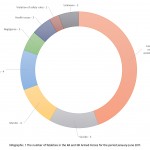
In the period January-June 2017, 36 death cases were recorded in the RA and Nangorno-Karabakh armed forces, 16 of which were ceasefire regime violations.
In the mentioned period 5 suicide cases were recorded, 4 murder cases and 4 fatal accidents; 2 death cases were the result of negligence, while 2 others were result of health issues; 1 soldier died of gunshot wound as a result of violation of safety rules.
The causes of death for 2 more death cases are yet unknown: 1 fatal gunshot wound and 1 biological death recorded as a result of deterioration of health.
4. Information related to the investigation of private soldiers Grigor Avetisyan’s and Souren Aramyan’s death cases.
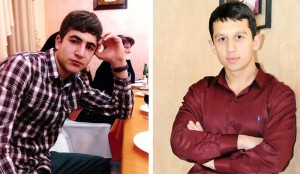 According to the official hypothesis on April 6, 2016, the bodies of two private soldiers Grigor Avetisyan and Suren Aramyan were found with gunshot wounds at the artillery firing range of the N military unit. A criminal Case was initiated by the 5th garrison division of the RA Investigative Committee under Article 104, Part 2, point 1 and 6 of the RA Criminal Code.
According to the official hypothesis on April 6, 2016, the bodies of two private soldiers Grigor Avetisyan and Suren Aramyan were found with gunshot wounds at the artillery firing range of the N military unit. A criminal Case was initiated by the 5th garrison division of the RA Investigative Committee under Article 104, Part 2, point 1 and 6 of the RA Criminal Code.
During the last three months a part from the criminal case of the double murder of Grigor Avetisyan and Souren Aramyan was separated and sent to the court. According to Peace Dialogue NGO expert Ruben Martirosyan who represents the interests of victims’ successors, this decision is illegal. “It contradicts the Article 28 (2) of RA Criminal Procedure Code (Separation of a criminal case against persons involved in one or several crimes is done by decision of the investigator, the prosecutor or the court, when this is necessary based on the facts of the case and cannot affect the completeness and objectivity of the case) according to which it is necessary to maintain the integrity and objectivity of the case .“- he argues.
Essentially, this decision of the preliminary investigation body is based on the confession testimony of serviceman Doumikyan, who afterwards renounced and has claimed so far that the testimonies were extracted from him. The preliminary investigative body arbitrarily interprets the “confession testimonies” of Davit Doumikyan, who “turned himself into” the police after the double murder, accepting his confession regarding the murder of one of the soldiers as true, while regarding the testimony about the murder of the other soldier as inaccurate.
The preliminary investigative body considered “proven” the fact that Doumikyan killed Gregory Avetisyan but did not consider proven that he also killed Souren Aramyan. The same self-confessed testimony indicates that he also killed Souren Aramyan, whereas the preliminary investigation body did not consider proven that Doumikyan killed Souren Aramyan. Therefore, the preliminary investigation body separated the part about Grigor Avetisyan’s death and sent it to court.
The senior investigator Tunyan of the Erebuni and Nubarashen administrative districts’ investigation department has instructed the head of Erebuni Police Department to investigate the following fact: Nubarashen Penitentiary institution detainee Khachatur Zohrabyan has reported that four other detainees in the same cell as Davit Doumikyan (he was accused of murder of two fellow servicemen during his army service) wanted to kill Doumikyan “expecting” to receive $ 50,000 from the client who is one of the deceased soldiers’ father Hermon Avetisyan. (See Peace Dialogue’s statement in Armenian)
PD believes that this is an attempt to put pressure on Doumikyan and threaten the unprotected soldier to force him to confess a crime he did not commit.
According to Article 59, part 11 of The RA Procedure Code the aggrieved party has the right to petition and receive the copy of the final court decision for the case and challenge it, whereas the aggrieved party was unable to do it for a long time because despite numerous petitions and demands, the preliminary investigation body was rejecting to provide the copy of the decision depriving the aggrieved party to exercise his right to challenge the decision.
Only after numerous appeals to different court instances over two years the aggrieved party was provided with the copy. After getting acquainted with that decision, the aggrieved party considers that it was subject to cancellation and has filed a petition to the prosecutor’s office, which will be presented subsequently.
On January 30, 2017, the aggrieved party reported on the crime committed by Investigator Gevorgyan, who is the investigator of the 5th Garrison investigative division of the Investigative Committee, and the head of the division.
According to the RA Criminal Procedure Code, the aggrieved party’s appeal was to be examined immediately, while it was supposed to be resolved within 10 days from the moment the report was received. However, no investigation was carried out over the mentioned report, while the Head of the Service, instead of carrying out an investigation, sent the report to the Chief Prosecutor.
The RA Prosecutor’s office, in its turn, instead of proceeding with the report of the aggrieved party as prescribed by law, sent the report to the same investigative group that is investigating the double murder case of the soldiers. It is noteworthy that Investigator Gevorgyan of the 5th garrison investigative division is also in this group and this is the same person the aggrieved party accuses of committing a crime. Therefore, he has no right to carry out the investigation simply because the investigator cannot investigate a case which examines the crime he committed and initiate a criminal case against himself.
Despite this, on May 31, 2017 the successor of the aggrieved party H. Avetisyan received a notice from the Investigative group calling him to the above-mentioned division to testify as a witness. It should be noted once again that the deadline for proceeding with the report of the aggrieved party expired on February 15, 2017.
5. Update on the court case of the death of Private Manuchar Manucharyan
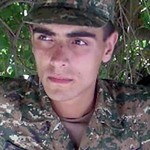 In July 2016, the court ruled a decision over Manuchar Manucharyan’s case appointing additional posthumous forensic examination.
In July 2016, the court ruled a decision over Manuchar Manucharyan’s case appointing additional posthumous forensic examination.
As a basis for such a decision the Judge considered the fact that there were substantial contradictions between the testimonies given by the witnesses during the preliminary investigation and the trial which do not allow the court to make definite conclusion on the following issues:
a) Was M. Manucharyan in the state of great agitation at the time of the incident? Could he commit a suicide?
b) Is there a cause-and-effect relation between M. Manucharyan’s alleged suicide and A. Stepanyan’s and B. Gaboyan’s actions? In other words, did Stepanyan and Gaboyan, with their illegal actions drive Manucharyan to commit suicide?
Just nine months after the court’s decision to appoint an additional posthumous examination, the aggrieved party received an expert opinion where, in response to the above-mentioned questions, the expert psychologists wrote, in particular: “Because the different findings in the criminal case are highly contradictory , given the fact that evaluation of the validity of that information is beyond the scope of the psychologist’s expertise, it is not possible to make definite conclusions over the cause-effect relation between the actions of M. Manucharyan as well as B. Gaboyan and A. Stepanyan and M. Manucharyan’s mental state during the period preceding his death.”
The third question addressed to the experts was the following:
“Had there been any signs of pathological affect and other emotional state observed in Manucharyan until July 29, 2013. If yes, what kind of effect could they have on this conscious and actions in the mentioned period?”
The answer to that question is also in line with the previous opinion of the experts.
“Because the different findings in the criminal case are highly contradictory , given the fact that evaluation of the validity of that information is beyond the scope of the psychologist’s expertise, it is not possible to make definite conclusions over the cause-effect relation between the actions of M. Manucharyan as well as B. Gaboyan and A. Stepanyan and M. Manucharyan’s mental state during the period preceding his death.
In case the facts provided by L. Mkrtchyan during the preliminary investigation and trial, the facts provided by A. Sahakyan and A. Abrahamyan during the preliminary investigation and the information available in the case files are evaluated as credible information by the body conducting the proceedings, it will be possible to conclude that M. Manucharyan was in the state of extremely emotional state prior to his death…”
Essentially, experts refuse to give conclusions, reasoning that the information contained in the case is very contradictory. Following that logic it should have been enough for them to simply say that verifying the validity of the information is beyond the competence of a psychologist-expert, whereas, contrary to what they wrote, they still went beyond that boundary and entered the legal field advising the court on how their conclusion must be assessed without having the right to do so.
In connection with M. Manucharyan’s case it should be noted that after a 9-moth break, during the trial held on May 30, 2017 the Court heard the opinions of the parties on the additional expert conclusion.
In the end of the trial, the aggrieved party presented two motions for sending M. Manucharyan’s trousers for an additional forensic examination, which would allow to determine the origin of a 5mm diameter round hole on the pants with traces of burn on the edges (whether it was a mechanical damage or a gunshot).
The experts gave no answer to this question. It should be noted as a reminder that the expert announced at Court that M. Manucharyan’s trousers were not examined, whereas in the 4th paragraph of the section “Questions for clarifications’ investigator wrote the following:
“Are there traces of a gunshot on M. Manucharyans clothes? If yes, what caliber weapon were fired and how many shots were required for them?”
In response to this question the expert wrote that there were no gunshot or mechanical damages found on the trousers. In its following hearing dated 12.06.2017 the Court rejected both motions made by the aggrieved party.
6. Update on the court case of the death of Private Haroutyun Hambaryan
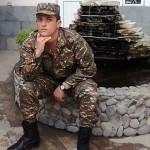 Peace Dialogue NGO continues to represent the interests of the victim’s successor at court in the murder case of Harutyunyan Hambaryan. According to the official hypothesis private Haroutyun Hambaryan shot himself in the forehead on May 8, 2015 from a rifle gun attached to him and died immediately. The same day the 3rd garrison division of the RA Investigative Committee initiated a criminal case and an investigative group was formed.
Peace Dialogue NGO continues to represent the interests of the victim’s successor at court in the murder case of Harutyunyan Hambaryan. According to the official hypothesis private Haroutyun Hambaryan shot himself in the forehead on May 8, 2015 from a rifle gun attached to him and died immediately. The same day the 3rd garrison division of the RA Investigative Committee initiated a criminal case and an investigative group was formed.
As we have noted in our previous report in the first quarter of the 2017 the Syunik Court of First Instance issued two decisions connected with the case of Hambaryan.
With one of these decisions the court satisfied the complaint filed by the aggrieved party against the court decision made in May 2016 over terminating the case of suicide.
The Court examined the complaint and decided that the complaint is justified and recorded violations of rights and freedoms of the aggrieved party and then gave a number of instructions to Prosecutor Aghabekyan over the investigation of the case. The latter allegedly implemented and is implementing the court decision, however, according to Peace Dialogue NGO expert R. Martirosyan, his actions are unlawful since before the examination of Hambaryan’s murder or suicide case, he was obliged to eliminate the decision of terminating the suicide case mentioned above: no dismissal proceedings are to be carried out until it the case has been dropped. The aggrieved party filed a complaint to the prosecutor’s office on this issue, but there has been no answer yet.
Only after the complaint filed by the aggrieved party, based on the complaint the court decided to remove the case from suspension and send it to the Investigation Department.
7. The Administrative Court rejected the requirement to force the Ministry of Defense to provide information to Peace Dialogue
The RA Administrative Court, presided over by Judge Karen Zarikyan during the court hearing on April 18, 2017 rejected the lawsuit filed by Peace Dialogue NGO against the RA Ministry of Defense requesting that the ministry provides official information on the death of soldiers for the period of 1994-2014, including the full names of the deceased soldiers, the location of the incidents, the dates, the unit numbers, the respective unit commander’s full names and ranks, the cause of death and a brief description of the incident.
After applying to the Ministry of Defense to receive the above-mentioned information, the organization filed a lawsuit requesting to oblige the Minister of Defense to provide the requested information and demanded administrative charges brought against then Defense Minister S. Ohanyan.
A court decision was made to temporarily suspend the hearing of these lawsuits since the final decision was connected with a court decision that was to be made over another lawsuit filed by Peace Dialogue which challenged the legitimacy of the classification of secret information as described in Section 17, Point 42 and 43 of the list provided by Executive Order N9 of the then Defense Minister Seyran Ohanyan and to partially annul the executive order.
The organization has sent an appeal to the European Court of Human Rights (ECHR).
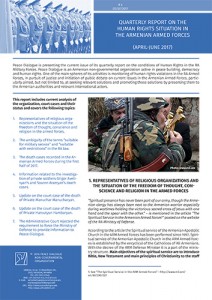 Download Quarterly Report on the Human Rights Situation in the Armenian Armed Forces / Vol.4 / (Period: April -June, 2017) (Version: pdf, 564 kB)
Download Quarterly Report on the Human Rights Situation in the Armenian Armed Forces / Vol.4 / (Period: April -June, 2017) (Version: pdf, 564 kB)



